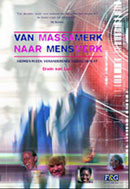The book is primarily written for marketing, media, branding, communications, and design specialists. Even so, the book appears to be very readable for those who haven’t gone deeply into branding yet. These readers might benefit from this steam course branding.
For most people, brands are more than labels in clothes, logos on buildings, and names of cars. Memories, sometimes even from early childhood, often are built up around brands. Which bank did dad do his banking with? What car did we drive? What brand peanut butter did we eat? Besides these nostalgic memories, brands provide us with daily topics of discussion. For example, people talk a lot about TV commercials, or about coaching brand experiences: a new car, sunglasses, new clothes, a CD, or a vacation experience. Thus, to some extent everybody is a brand expert. In our brains all personal experiences, bits of advertising, and conversations are put together to one complex network of associations with the brand. Brands therefore are much more than just a label, a word, or a logo.
The brand association network in our brains hugely influences our buying behavior. If a certain brand is taken into consideration when buying a certain product or service, memories around the brand come back (the brand image is activated). Not as individual memories, but as the image which has been built up based on earlier experiences. Compare the experiences with other people: you build up an image of somebody, but you forget many of the individual experiences you have based this image upon. Because the brand image is activated in the brains, people look differently at products of a know brand than at products of an unknown brand. And thus they judge brands they have positive associations with as better, tastier, a better fit. These associations are the starting point for every new brand experience. They already look forward to them, which makes their choice between brands a very subjective one.
Therefore, it is very important for marketers to create positive associations with the brand. These positive associations should be in line with the products belonging to the brand. Two totally different Unilever products for example, say potato chips and body lotion, could never be offered under the same brand. Certain products just don’t go together. When Mary is pampering herself with body lotion, she doesn’t want to think about potato chips. And the same goes for the opposite: when she eats potato chips, she doesn’t want to think about body lotion. Large companies therefore often have a series of different brands, belonging to different products, connected through a certain brand architecture. Unilever for example has hundreds of brands in its portfolio. Besides, the company itself evokes associations as well, which is why the company itself is seen like a brand too. The company brand - in this case Unilever - is called corporate brand. Sometimes corporate brands and product brands correspond, for example Starbucks, Nike or Rabobank. The corporate brand too should evoke positive associations, and be in line with the products offered by the company.
The use of mass media has always been an important way to create the desired associations. First through newspapers, and later through radio, cinema, and television: marketers have always used the available media in an optimal combination. These media are pre-eminently suitable for creating associations in the heads of consumers, in an order the marketer can choose. With the coming of Internet and other technologies however, ‘advertising’ is changing. More and more often the consumers are in charge themselves, and they decide when they want to consume the communications of the brand. Marketers thus seem to lose control. Brands however won’t cease to exist: as long as there are people, there are association networks, and there are brands. Even though the media context is changing. The concept of brands is ageless.
 My book ‘Van Massamerk naar Mensmerk’ (From Mass Brand to Personal Brand, Dutch) describes how our media context will change over the coming ten years, how marketing and brands will adapt to this, and how today’s professionals can anticipate. Every day we work on making the world a better place, on a worldwide basis. Every day the future gets one small step closer. As we can take these small steps ourselves today, I closely follow the evolution of media, marketing and brands in the tab
My book ‘Van Massamerk naar Mensmerk’ (From Mass Brand to Personal Brand, Dutch) describes how our media context will change over the coming ten years, how marketing and brands will adapt to this, and how today’s professionals can anticipate. Every day we work on making the world a better place, on a worldwide basis. Every day the future gets one small step closer. As we can take these small steps ourselves today, I closely follow the evolution of media, marketing and brands in the tab  In 2005 my book ‘Van Massamerk naar Mensmerk’ (From Mass Brand to Personal Brand, Dutch) received a top-3 nomination for the Dutch Marketing Literature Award of the year. This prize is presented by the Dutch Platform for Innovation in Marketing (
In 2005 my book ‘Van Massamerk naar Mensmerk’ (From Mass Brand to Personal Brand, Dutch) received a top-3 nomination for the Dutch Marketing Literature Award of the year. This prize is presented by the Dutch Platform for Innovation in Marketing (